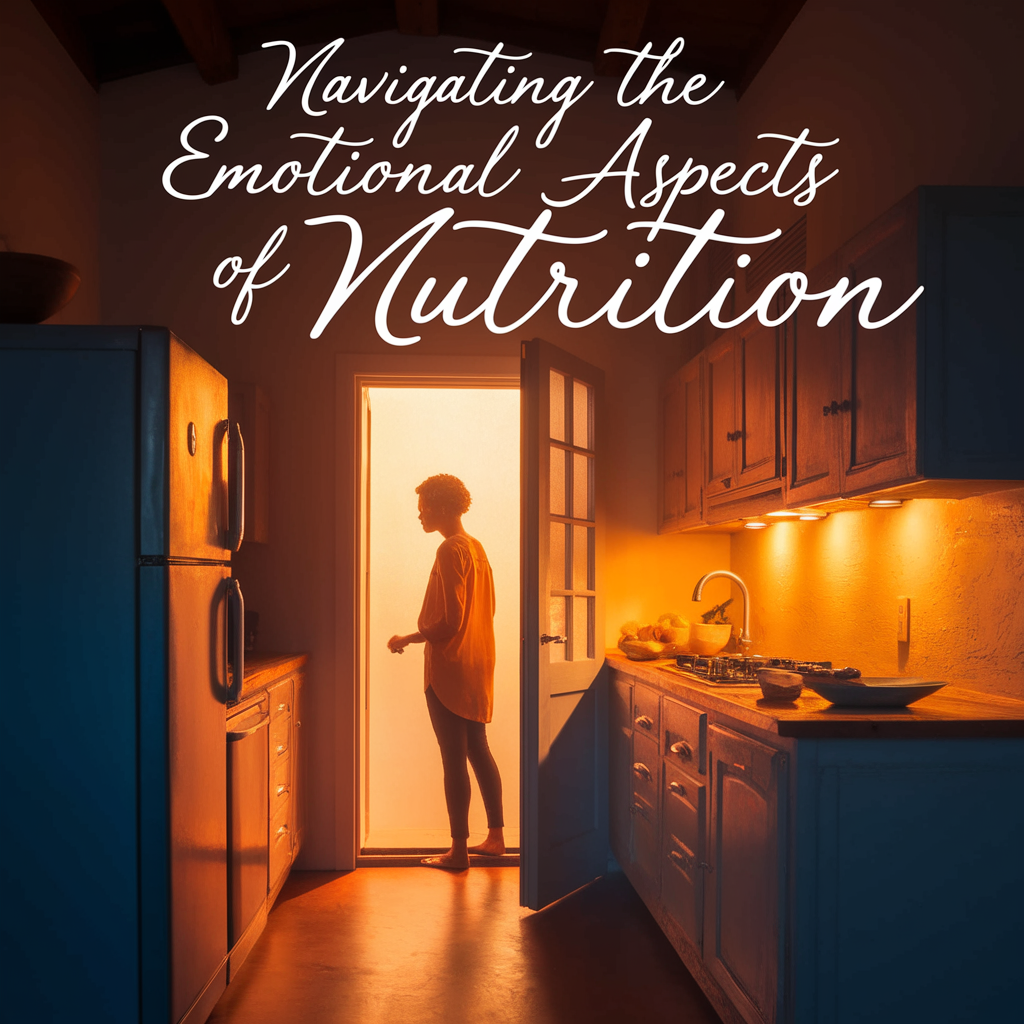Navigating the Emotional Aspects of Nutrition
The relationship we have with food is complex, almost like a rollercoaster ride through a theme park of emotions. As I sat down to write about the emotional aspects of nutrition, I couldn’t help but reflect on my own experiences—those times when I turned to a tub of ice cream after a rough day or opted for a green smoothie to celebrate a small victory. It struck me that our choices around food are often intertwined with our feelings, memories, and even our identities. But how do we navigate this intricate landscape? Let’s dive in.
The Emotional Connection to Food
Food is more than just fuel; it’s a language of love, comfort, and sometimes, sorrow. Research indicates that many of us have emotional triggers tied to our eating habits. For instance, think about the last time you celebrated a birthday. What was on the table? Cake, right? That sweet slice of joy isn’t just a dessert; it’s a symbol of happiness and togetherness. Conversely, during times of stress or sadness, many individuals find solace in their favorite comfort foods—think of that classic mac and cheese, or perhaps a hearty bowl of chili. It’s like a warm hug in a bowl, isn’t it?
Some studies suggest that around 75% of overeating is tied to emotions rather than physical hunger. This statistic is a wake-up call for those of us who might think we’re just indulging because we can. The truth is, emotional eating can lead to a cycle of guilt and shame, which can further exacerbate emotional distress. So, what’s the solution? Understanding that emotional connection can be the first step in addressing our relationship with food.
Identifying Emotional Triggers
Let’s get practical. Recognizing your emotional triggers is crucial. Keep a food diary for a week, noting not just what you eat, but how you feel at that moment. Were you stressed, happy, or maybe bored? This simple act can reveal patterns. For instance, I noticed that on days I felt overwhelmed with work, I gravitated toward snacks that were high in sugar—a temporary pick-me-up that eventually left me crashing and craving more.
Here are some common emotional triggers that might resonate:
- Stress: Reaching for chips during a hectic workday?
- Boredom: Snacking out of sheer habit while binge-watching your favorite series?
- Celebration: Enjoying a fancy meal when you land that big promotion?
- Loneliness: Finding comfort in food when you’re feeling isolated?
Recognizing these moments can help you distinguish between emotional hunger and physical hunger. Physical hunger tends to be gradual, while emotional hunger can strike suddenly and often comes with cravings for specific comfort foods. It’s a mind game, and you’re the player.
Food as a Coping Mechanism
When life gets tough, it’s natural to seek solace in food. But depending on it as a coping mechanism can lead to unhealthy patterns. I recall a time when I faced a significant personal setback; comfort foods became my go-to. While it provided a temporary escape, it also led to a sense of guilt that lingered long after the last bite. Sound familiar?
For many, food serves as a distraction from uncomfortable feelings. Instead of sitting with sadness or anxiety, we munch our way through the discomfort. This is where things can get tricky. Eating as a coping strategy can lead to a cycle of emotional eating that feels unbreakable. To shift this pattern, it’s vital to develop healthier coping strategies.
Healthier Coping Strategies
Instead of reaching for that pint of ice cream, consider alternatives that can soothe your soul without the emotional baggage. Here are a few ideas:
- Journaling: Write down your feelings. It can be incredibly cathartic.
- Exercise: Go for a walk or hit the gym. Physical activity can elevate your mood.
- Meditation: A few minutes of mindfulness can help center your thoughts.
- Talk it out: Sometimes, just chatting with a friend can make a world of difference.
Developing these alternatives can help break the cycle of emotional eating. It’s about finding what works for you and building a toolbox of strategies to draw upon when life gets a little too heavy.
The Role of Mindfulness in Eating
Mindfulness is a buzzword that’s become increasingly popular in the wellness community, and for good reason. Practicing mindfulness while eating can help you reconnect with your body’s hunger cues and emotional states. I remember the first time I tried mindful eating—it felt awkward, like trying to learn to ride a bike all over again. But the benefits were undeniable.
Mindful eating involves paying attention to the experience of eating, from the taste and texture of food to how it makes you feel emotionally. This practice encourages you to slow down, making it easier to identify emotional triggers and physical hunger cues. Here’s how you can incorporate mindfulness into your meals:
- Focus on your food: Sit down at a table, put away distractions like phones or TVs, and really engage with your meal.
- Chew slowly: Take your time with each bite, savoring the flavors.
- Notice your feelings: Pay attention to how you feel before, during, and after your meal.
By practicing mindfulness, you may find that you experience greater satisfaction from your meals and, ultimately, make healthier choices.
The Impact of Social Influences
Let’s face it—food is often a communal experience. Our dining habits are heavily influenced by those around us, from family traditions to social gatherings. I often chuckle when I think back to family dinners where everyone’s eyes were glued to the table, eagerly awaiting the spread of lasagna—a recipe that has been passed down through generations. Food brings us together, but it can also complicate our emotional relationship with eating.
Consider the last time you attended a social event. Did you feel pressure to indulge simply because everyone else was? Social gatherings can lead to what’s known as “social eating,” where we consume foods not out of hunger but due to the environment around us. It’s important to recognize that it’s okay to say no to that extra slice of cake or to choose a salad instead of fries, even if everyone else is digging in.
Setting Boundaries
Setting boundaries around food in social situations can be challenging but is crucial for maintaining a healthy relationship with eating. Here are a few strategies to consider:
- Plan ahead: If you know there’s going to be a spread at a party, decide in advance what you’ll indulge in.
- Communicate: Let friends know your dietary preferences or goals; you might be surprised at their support.
- Practice moderation: Allow yourself to indulge but keep portions in check. One cookie instead of the whole plate can make a difference!
By setting these boundaries, you can enjoy social events without compromising your emotional health or dietary goals.
Cultural Perspectives on Food and Emotion
It’s fascinating to explore how different cultures view the emotional aspects of food. In many cultures, food is a central part of celebrations, rituals, and even healing. For instance, in some Asian cultures, food is seen as a way to nurture and care for loved ones, while in others, sharing meals is a demonstration of respect and community.
As a sports journalist, I’ve traveled far and wide, tasting everything from spicy street tacos in Mexico City to delicate sushi in Tokyo. Each meal was not just about taste; it was about connection. I remember a dinner in Italy where the host shared stories behind each dish, transforming a simple meal into an emotional journey through family history. It was a reminder that food is deeply tied to our identities and experiences.
Understanding these cultural nuances can help us appreciate our own relationship with food. It’s not just about what’s on our plates; it’s about the stories, traditions, and emotions that accompany each bite.
The Healing Power of Food
Interestingly, many cultures also have healing foods—dishes that are believed to nourish not just the body but the soul. Comfort foods, herbal brews, and hearty stews often come with stories of love and healing passed down through generations. For example, chicken soup is often dubbed “the ultimate comfort food” across various cultures, associated with care during times of illness or distress.
So, how do we harness the healing power of food? Consider incorporating nourishing ingredients into your meals that not only satisfy your palate but also uplift your spirits. Think of fresh fruits, vibrant vegetables, and whole grains as your allies in promoting emotional well-being.
Seeking Professional Support
While self-awareness and coping strategies can significantly improve your relationship with food, sometimes we need a little extra help. Seeking support from a registered dietitian or a therapist specializing in emotional eating can provide personalized guidance. These professionals can help you navigate the emotional aspects of nutrition in ways that are tailored to your individual needs.
During my own journey, I found a dietitian who helped me untangle my emotional ties to food. Together, we explored my eating habits, identified triggers, and developed a plan that honored my emotional needs without compromising my physical health. It was a game-changer for me, and I can’t emphasize enough the value of seeking support when needed.
Creating a Supportive Environment
Creating a supportive environment at home can make a world of difference in your emotional relationship with food. Surround yourself with nourishing options, and invite family or friends to join you in cooking healthy meals. This not only fosters a sense of community but also reinforces positive eating habits.
Here are a few tips to cultivate a supportive environment:
- Stock up on healthy snacks: Replace chips with fruits, nuts, or yogurt.
- Cook together: Involve loved ones in meal prep to make it a fun, shared experience.
- Practice gratitude: Before meals, take a moment to appreciate the food and the effort that went into preparing it.
Creating a nurturing atmosphere around food can help reinforce positive emotional connections and encourage healthier choices.
In Conclusion
Navigating the emotional aspects of nutrition is an ongoing journey, filled with ups and downs. It’s about understanding our relationship with food, recognizing emotional triggers, and developing healthier coping strategies. While it can be a challenging path, it’s also an opportunity for growth and self-discovery. Through mindfulness, cultural appreciation, and seeking support, we can create a healthier relationship with food that honors our emotional needs.
As I reflect on my own food journey, I’m reminded that it’s not merely about what we eat but how we feel about it. So, the next time you find yourself reaching for that comfort food, try to pause and ask yourself—what’s really going on here? By tuning into our emotions and making conscious choices, we can navigate the rollercoaster of nutrition with grace and intention.






